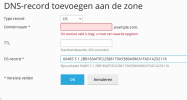Johndenkis
New Pleskian
We are trying to add DS-records to a DNS-zone to activate DNSSEC but since one of the last Plesk updates, the domain field became required. This means you are only allowed to add DS-records in a sub-domain case. This used to me allowed even if the domain field is empty and it has always worked like it should. We can't even update existing DS-records in which the domain field is empty now for it is required.
Steps to reproduce:
In Plesk, go to Websites & Domains -> example.com -> DNS settings, try to add a new DS-record and don't fill in the (sub)domain field.
Suggested solution:
Remove the GUI required field check on the domain field when someone adds a new DS-record, or edits an existing one.
Plesk Obsidian Web Host Edition 18.0.64 Update #1

Steps to reproduce:
In Plesk, go to Websites & Domains -> example.com -> DNS settings, try to add a new DS-record and don't fill in the (sub)domain field.
Suggested solution:
Remove the GUI required field check on the domain field when someone adds a new DS-record, or edits an existing one.
Plesk Obsidian Web Host Edition 18.0.64 Update #1

